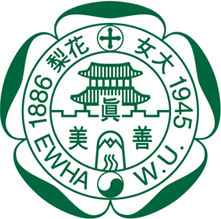Meaning and History

The emblem of Ewha was first adopted in 1930.
It is believed that Acting President Edna M. Van Fleet designed the emblem after collecting teachers’ suggestions at a faculty meeting,
while President Appenzeller went to the United States to raise funds to build the Shinchon campus.
Van Fleet, who majored in children's education, served for 20 years from 1918 as a superintendent and professor of Ewha’s Childcare School. She taught literary history and art history to students at Ewha Professional School, with deep affection and insight into Korean traditional culture and art. At the time two versions were created; one for Ewha College and the other for Ewha Kindergarten Teaching School (K.T.S.).
Made of pure silver, the emblem originally depicted the five petals of a pear blossom, with two circles inside. A Taegeuk mark (yin and yang) was located right over the circles and a small pear blossom was beneath the circles. Two or three years later, a cross replaced the original Taegeuk mark, which was moved to the pear blossom’s original position. To left and right of the Taegeuk mark, “Ewha College” and 梨花專門 (EWHA K.T.S. and 梨花保育 in the case of Ewha Kindergarten Teaching School) were written. Two years also were featured on the emblem; 1910 on the left, referring to the year when the college major was created and 1925 on the right, when Ewha College was founded. The small circle contained a drawing of Namdaemun (the South gate of former Seoul) and the school motto, “Jin, Seon, Mi” (truth, goodness, beauty) was encrypted in a triangular form beneath it.
During Japanese colonization, the Japanese General government of Chosun forced Ewha to make changes to the emblem. Namdaemun and Taegeuk, which were considered to be Korean national symbols, were erased. Only the cross remained and the material it was made of was changed from pure silver to lead in 1939. With the liberation of Korea, it regained its original design.
In the current emblem, the two original years (1910 and 1925) have been replaced by 1886 and 1945, representing the year of the establishment of Ewha Haktang and the year of the establishment of Ewha Womans University. The two circles symbolize the revelation of God, and the cross symbolizes the Christian spirit, which is the foundation and ultimate goal of Ewha's establishment. The Taegeuk is a symbol of Oriental philosophy that shows the foundation of the creation of all creatures, and is also in the national flag of Korea. Namdaemun is representative of the Korean nation and Jin, Seon, Mi(眞. 善. 美) is the school motto that describes Ewha’s spirit.
The general image of Ewha's emblem is a symbol of the integrity and modesty of elegant students who aim to grow towards knowledge and goodness. Ewha’s ultimate goal is to obtain wisdom and knowledge based on the truth, to practice goodness for the community and to pursue beauty through artistic sentiment. The open gate of Namdaemun and a narrow path right under it with the letters Jin, Seon, Mi depict how harsh and difficult it is to reach jin, seon and mi.
College Emblem
Each College uses a different representing color in the center of its emblem. The representative color for each college was first applied to six colleges in 1975. The full modification was carried out in 1965 according to the Academy Color Encoding System (ACES) and in 2002 according to international standard color codes and Korea’s standard color codes. The current representative color for each college emblem was adopted in 2011 when Ewha built the University’s Visual Identity as part of the 125th foundation anniversary project.
-
Liberal Arts
- Pantone427 C
- CMYKC0 M0 Y0 K11
- RGBR227 G227 B227
-
Social Sciences
- Pantone2925 C
- CMYKC85 M24 Y0 K0
- RGBR43 G133 B187
-
Natural Sciences
- Pantone7406 C
- CMYKC0 M0 Y18 K100
- RGBR255 G209 B0
-
ELTEC Engineering
- Pantone179 C
- CMYKC0 M79 Y100 K0
- RGBR255 G54 B0
-
Music
- Pantone708 C
- CMYKC0 M46 Y22 K0
- RGBR250 G139 B153
-
Art & Design
- Pantone730 C
- CMYKC0 M38 Y78 K29
- RGBR180 G112 B32
-
Education
- Pantone631 C
- CMYKC67 M0 Y12 K2
- RGBR83 G185 B191
-
Medicine
- Pantone354 U
-
Convergence
- Pantone286 C
-
Business Administration
- Pantone161 C
- CMYKC0 M52 Y100 K64
- RGBR92 G44 B1
-
Nursing
- Pantone714 U
-
Pharmacy
- Pantone144 C
- CMYKC0 M48 Y100 K0
- RGBR255 G133 B0
-
Scranton
- Pantone3258 C
- CMYKC59 M0 Y33 K0
- RGBR105 G194 B159














